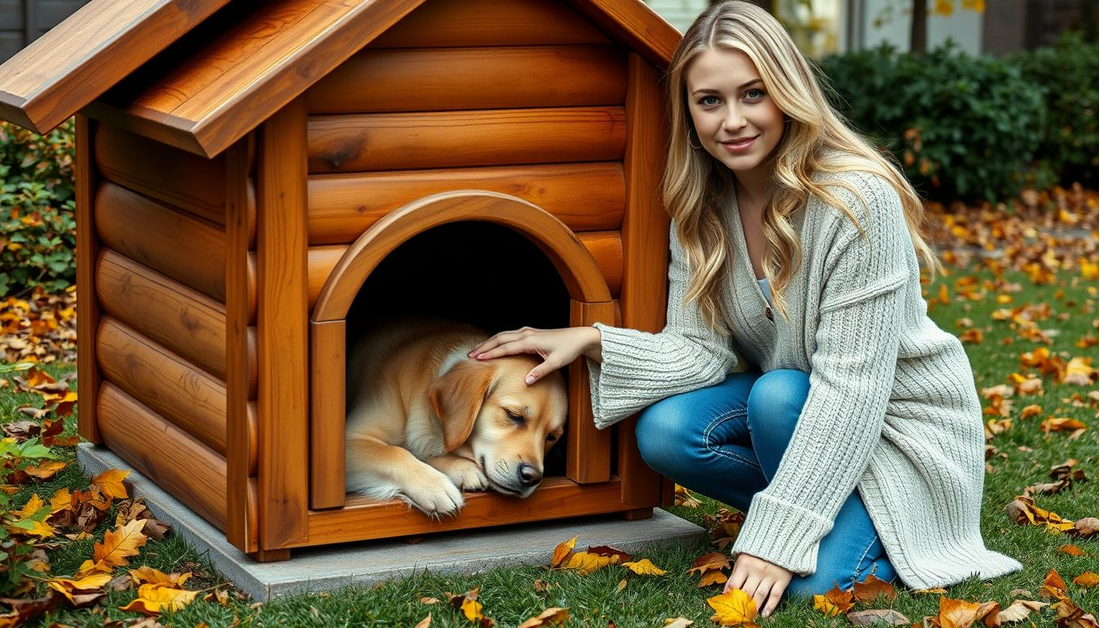India customers to view on amazon.in
“Please note that no animals were harmed in the making of this content.”
What Makes the Perfect Dog House? Let’s Break It Down
Building the perfect dog house is more than just a shelter. It’s about creating a safe, functional space your pet will love. Whether you’re looking at dog house ideas or premium dog houses, the best design balances comfort, durability, and style.
- Understanding the Key Elements of a Perfect Dog House
- Importance of Location and Setup
- Insulation and Ventilation Considerations
- Accessibility and Entryway Design
- Choosing the Right Materials for a Durable Dog Shelter
- Innovative Designs for a Modern Dog Shelter
- Custom Features to Enhance Your Outdoor Dog Kennel
- Expert Dog House Construction Tips for All Seasons
- Creating a Cozy and Comfortable Living Space for Your Pet
- Practical Dog House Size Guide and Layout Considerations
- Ventilation, Insulation, and Overall Dog House Comfort
- Conclusion
- FAQ
- What are the ideal features of a perfect dog house?
- How do I choose the right size for my dog house?
- What materials are best for building a durable dog shelter?
- Are there insulated dog houses available for winter?
- What is the best way to ensure ventilation in a dog house?
- How can I make my dog house more comfortable for my pet?
- Are there any DIY dog house plans available online?
- What are some creative dog house ideas for a small backyard?
- How can I customize a dog house for my pet’s specific needs?
- What are the essential dog house construction tips for beginners?
Every detail matters, from insulation to entryway size. This guide will show you how location, materials, and planning turn a simple shelter into a haven.

Key Takeaways
- Location and airflow are key to keeping pets safe year-round.
- Insulation and ventilation work together to protect against harsh weather.
- Entry height and width must match your dog’s breed and size.
- Premium dog houses use materials like cedar or plastic for long-term durability.
- Smart design combines aesthetics with practical features like easy cleaning.
Understanding the Key Elements of a Perfect Dog House
A safe outdoor dog house needs more than just walls and a roof. Let’s look at the main features that make a good space for your pet.

Importance of Location and Setup
Choose a spot that keeps the outdoor dog kennel safe from bad weather. Stay away from low areas that might flood. Quality pet housing starts with a solid base—raise it a bit for better drainage and air flow.
- Face the entrance away from strong winds
- Check local rules for where you can put it
- Make sure it’s easy to clean and maintain
Insulation and Ventilation Considerations
A durable dog shelter must handle extreme temperatures. Use weather-resistant materials for walls and roofs. Good ventilation stops mold and humidity:
- Add small vents near the roof for air flow
- Use insulated panels for cold weather
- Install adjustable flaps for different seasons
Accessibility and Entryway Design
Choose a dog crate entrance that’s wide enough for your pet to move easily. The entry should:
- Have a waterproof flap to keep out rain and drafts
- Be low to the ground for older or smaller dogs
- Include secure latches for safety
Putting these elements together makes a safe outdoor dog house that’s both practical and protective. Every detail, from location to entry design, keeps your pet comfortable all year.
Choosing the Right Materials for a Durable Dog Shelter
Pet parents know that picking the best materials for dog houses is crucial. It ensures a safe, long-lasting outdoor space. The right dog house features depend on the climate, size, and how long it lasts. For example, a wooden dog house is strong and keeps warm but needs regular care.

Wood is a favorite choice for many. Cedar and pine are good because they resist rot and are light. They’re perfect for keeping your dog house insulated. But, stay away from treated lumber to avoid harmful chemicals.
For really harsh weather, choose pressure-treated wood or composite materials. They fight off moisture well.
Plastic or vinyl dog houses are easy to clean and light. But, they don’t keep cold out as well. Metal is strong but can get too hot in summer. A good mix is using wooden frames for strength and adding foam insulation to keep it cozy all year.
| Material | Pros | Cons |
|---|---|---|
| Wooden Dog House | Insulation, durability | Requires sealing |
| Plastic | Low maintenance | Less insulating |
| Composite | Weather-resistant | Higher cost |
Good airflow and drainage are key. For example, a wooden dog house with a raised base and screened vents is great. It lets air in without letting cold out. Making these choices keeps your pet’s shelter cozy and safe all year.
Innovative Designs for a Modern Dog Shelter
Today’s dog shelters blend the latest in design with comfort for pets. Whether you’re designing the best dog shelter for your backyard or a park, the latest dog house design trends focus on both looks and function. These structures not only beautify outdoor areas but also keep pets safe.

Modern Aesthetics and Functionality
Modern dog shelters are made from materials like weather-resistant cedar or recycled plastic. Brands like PetHaven offer pet house plans with features like solar-powered lights or heated floors. These designs not only protect pets but also enhance gardens or modern homes.
For example, flat-roofed modern dog houses with skylights let in natural light and keep rain out.
Incorporating Space and Style
Space-saving designs are essential. Below are three popular styles:
| Design Type | Features | Benefits |
|---|---|---|
| Modular Units | Adjustable partitions, stackable sections | Customizable for growing pets |
| Eco-Friendly Pods | Recycled materials, solar panels | Low environmental impact |
| Elevated Cabins | Raised base, ventilation slats | Improved airflow and pest resistance |
These pet house plans show that function and style can go hand in hand. Whether you’re building a modern dog house from scratch or updating an old one, focusing on smart designs ensures your pet’s comfort and style.
Custom Features to Enhance Your Outdoor Dog Kennel
Every dog deserves a space that fits their personality and needs. Custom dog house features like a porch or shade can make basic shelters cozy. Think about your pet’s habits—does your dog love morning light or seek shade? A dog house with porch or shade offers flexibility, shielding pets from harsh weather while keeping them close to you outdoors.

- Porches with slatted roofs create natural airflow and sun protection.
- Adjustable walls let owners modify space as puppies grow into adults.
- Integrated drainage floors prevent waterlogging during rains.
| Feature | Key Benefit | Quick Tip |
|---|---|---|
| Porch Extension | Reduces heat exposure by 30% | Add a 3ft overhang for optimal shade |
| Rainproof Roofing | Blocks 90% of rainfall | Use EPDM rubber for seamless drainage |
| Modular Walls | Expandable up to 50% larger | Choose interlocking panels for easy upgrades |
Following the pet owner’s guide to dog houses ensures safety without sacrificing style. Always pair customizations with proper ventilation checks. When choosing the right dog house for your pet, prioritize materials like cedar for durability. Consider local climate extremes. Small breeds may need smaller porches, while large dogs benefit from taller entryways. Every tweak turns a basic shelter into a personalized sanctuary your pet will love!
Expert Dog House Construction Tips for All Seasons
Building a durable dog house is more than just using tools and materials. Follow these dog house construction tips to keep your pet cozy in any weather. Whether you’re choosing a dog house design or building dog house from scratch, these steps make it easier.

“A well-insulated dog house is like a year-round blanket—it adapts to any climate.”
Step-by-Step Construction Guidelines
- Plan dimensions based on your dog’s size. Make sure there’s enough space for movement but not so big it’s hard to stay warm.
- Use pressure-treated wood or cedar for rot resistance. Line walls with foam board insulation and waterproof roofing.
- Install a raised floor to prevent moisture buildup. Add a hinged roof for easy cleaning access.
- Position the entrance away from prevailing winds. A flap over the doorway blocks drafts.
Cost-Effective Building Solutions
- Reuse scrap wood or buy pre-cut lumber to cut costs.
- Layer old carpets as insulation in tight budgets—avoid synthetic materials.
- Paint with weatherproof outdoor paint instead of buying expensive treated wood.
By following these how to build a cozy dog house strategies, you’ll create a reliable dog house for all seasons. Make sure to prioritize ventilation without losing warmth. Test your design against local weather extremes. Your dog’s comfort depends on thoughtful details—like angled roofs to shed snow or breathable mesh vents for summer.
Creating a Cozy and Comfortable Living Space for Your Pet
A safe and comfortable dog house is just the start. Turn it into a true sanctuary with these tips. Focus on a design that balances insulation, ventilation, and seasonal care. This will keep your pet happy all year.
Maintaining Warmth During Winter
Keep your dog snug in cold weather with these steps:
- Choose an insulated dog house for winter with thick walls and a draft-blocking entrance flap.
- Add non-absorbent bedding like straw or fleece to retain heat without trapping moisture.
- Maintain airflow with small gaps for dog house ventilation and comfort, preventing mold without letting in cold drafts.

Seasonal Adjustments for Comfort
Adapt the space for each season:
- Summer: Add shade, mesh panels, or a small fan to boost airflow and reduce heat buildup.
- Winter: Check the safe dog house for leaks and reinforce insulation against freezing temperatures.
- Spring/Fall: Rotate bedding and clean floors to eliminate allergens and humidity.
“Proper ventilation and insulation are vital for a pet’s health,” says the American Veterinary Medical Association.
Small adjustments create big differences. A well-ventilated, insulated dog house for winter and regular checks ensure your pet has a sanctuary that adapts to any weather.
Practical Dog House Size Guide and Layout Considerations
Choosing the right dog house size guide ensures your pet feels safe and comfortable. A well-designed backyard dog house starts with matching the structure to your dog’s size and your yard’s space. For small dog house options, dimensions should allow your pet to stand, turn around, and lie comfortably without excess space. Larger breeds need more room for movement and warmth retention.

- Small breeds (under 20 lbs): Aim for 2×3 feet minimum. Include low entryways to keep warmth in.
- Medium to large breeds: 4×6 feet or larger. Ensure high ceilings for headroom and airflow.
- Layout tips: Position the entrance away from prevailing winds. Add ramps for older or arthritic dogs.
“A properly sized dog house isn’t just shelter—it’s a health necessity. Space impacts their posture and overall well-being.” — Dr. Emily Carter, Veterinary Behaviorist
Key dog house features like adjustable bedding and weatherproof roofs enhance usability. For tight spaces, consider vertical storage solutions or attachable side compartments. Always leave 3–4 inches of clearance between your dog’s back and the roof. Prioritizing these details turns any backyard dog house into a tailored sanctuary, no matter the breed or space constraints.
Ventilation, Insulation, and Overall Dog House Comfort
Building the best dog house is more than just picking materials. It’s about airflow and insulation too. These elements keep pets safe all year. Whether you’re making a diy dog house or looking at dog shelter ideas, these details are crucial.

Optimizing Airflow and Ventilation
High, slatted roof vents help hot air escape. Screened side vents keep drafts out. For a dog house tips trick, place vents opposite each other for airflow. Don’t block vents with decorations or plants.
Maximizing Insulation Efficiency
Choose insulation based on your climate. Here’s a guide to materials and their uses:
| Material | Pros | Cons | Best Use |
|---|---|---|---|
| Rigid foam boards | Blocks extreme temps | Expensive | Freeze-prone zones |
| Recycled denim batts | Natural moisture control | Less durable | Humid climates |
| Fiberglass | Affordable | Requires careful installation | General insulation |
Ensuring All-Season Comfort
- Install removable panels to adjust insulation thickness with seasons
- Use waterproof canvas flaps over vents during rain
- Line floors with rubber mats for easy cleaning
Combine these dog shelter ideas with cozy bedding. A well-ventilated best dog house design is breathable and protective. It’s a cozy retreat for your pet all year.
Conclusion
A well-built outdoor dog house becomes a cozy home for your pet. It beats a dog crate in offering space and adapting to seasons. Insulation, ventilation, and strong materials keep your pet safe in any weather.
Good design in entryways and raised floors makes it practical and welcoming. This setup meets your dog’s needs, ensuring they’re safe all year. A well-thought-out dog home is more than a shelter; it’s a safe space that improves your pet’s life.
Every detail, from size to insulation, matters for your pet’s comfort. This makes a great outdoor dog house essential for every dog.
FAQ
What are the ideal features of a perfect dog house?
A great dog house is durable and well-ventilated. It should be insulated for all seasons. It needs to be the right size for your dog and have a safe entryway.
Adding a cozy interior and modern looks can make it more comfortable and stylish.
How do I choose the right size for my dog house?
Measure your dog while they’re standing and lying down. The house should let them turn around easily. Use a size guide based on your dog’s breed and size.
What materials are best for building a durable dog shelter?
Cedar wood, plywood, and insulated panels are top choices. Cedar resists decay, plywood is strong, and panels keep it cozy. Avoid untreated wood that can warp or rot.
Are there insulated dog houses available for winter?
Yes, there are insulated dog houses for winter. Look for double walls, thermal insulation, and raised floors. These features keep pets warm and dry.
What is the best way to ensure ventilation in a dog house?
Use windows or vents high on the walls for airflow. This keeps air fresh and warm inside. A sloped roof also helps heat escape.
How can I make my dog house more comfortable for my pet?
Add soft bedding and heat mats in winter. Offer shade in summer. Custom features like porches make it cozy.
Are there any DIY dog house plans available online?
Yes! There are many DIY plans online. Find tutorials that fit your skill level and style, from simple to elaborate.
What are some creative dog house ideas for a small backyard?
Use vertical designs or modular houses for small spaces. Decorative options can blend with your yard. A dog house can also be a garden feature.
How can I customize a dog house for my pet’s specific needs?
Add ramps for older dogs, storage for accessories, adjustable shading, or outdoor runs. Customizing ensures your dog has a safe, comfy space.
What are the essential dog house construction tips for beginners?
Start with a solid plan and quality materials. Ensure proper measurements and weatherproofing. Focus on safety and durability for all weather.







